
Which State Has More Venomous Snakes: Georgia or Louisiana?
Georgia and Louisiana are two states full of wilderness with endless outdoor parks and landmarks. From the Tallulah Gorge State Park with its cascading waters to the thick forests in the Kisatchie National Forest, nature is abundant. Along with wildlife such as elk, deer, coyotes, and more, both states are also home to many venomous snake species that tourists should look for. Whether it is the famed cottonmouth with its white mouth or the timber rattlesnake under the foliage, plenty of snakes thrive in these two states.
Venomous Snakes In Georgia

Among its 40+ snake species, ranging from the black rat snake to the common watersnake, Georgia is home to six venomous snake species. These include multiple rattlesnakes and notable names, such as the copperhead snake, all of which contain potent venom. That said, most also exist in Louisiana, so Georgia is only home to one unique poisonous snake species, the eastern coral snake.
Eastern Coral Snake (Micrurus fulvius)

The eastern coral snake, also known as the common coral snake, is a highly venomous sub-species of the family Elapidae. This snake is found in most of southeastern America and is prominent in states such as South Carolina, Georgia, and Florida. It can be identified by its large red and black rings separated by smaller yellow rings throughout the length of its body. On average, an eastern coral snake can reach a length of 31 inches, although some snakes have been noted to be as long as 48 inches. Regarding their venom, the eastern coral snake has a strong neurotoxin, which can cause pain, slurred speech, and paralysis in humans. While fatalities are rare, it is essential to seek medical attention if an eastern coral snake bites you. In the wild, these snakes use their neurotoxic venom to hunt other snakes, lizards, birds, frogs, and fish.
Venomous Snakes In Louisiana
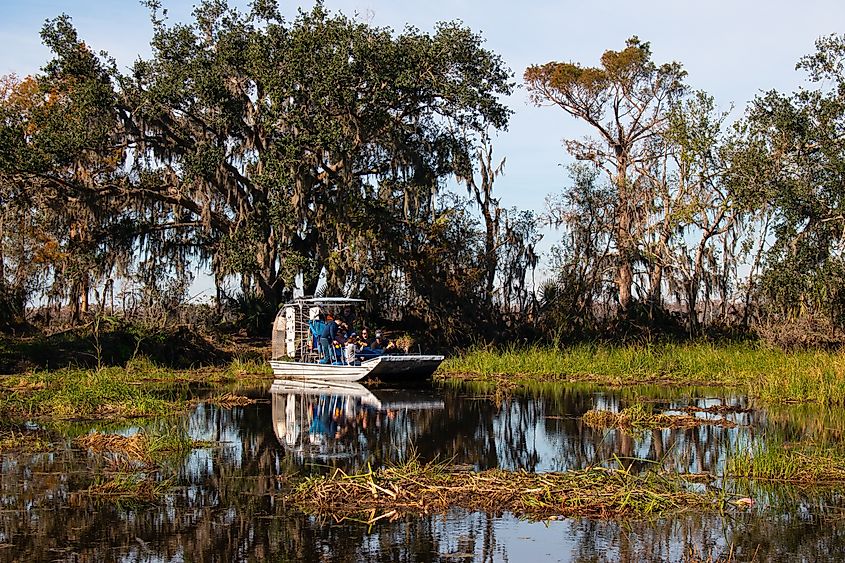
Similar to Georgia, Louisiana is also home to more than 40 snake species of various kinds. Some of the most common are the garter snake, banded water snake, and pygmy rattlesnake, one of the most venomous in the region. While most species are shared with Georgia, Louisiana is home to notable populations of the poisonous Texas coral snake. While it is also from the same family as the eastern coral snake, it is a unique species with many different traits.
Texas Coral Snake (Mirurus tener)
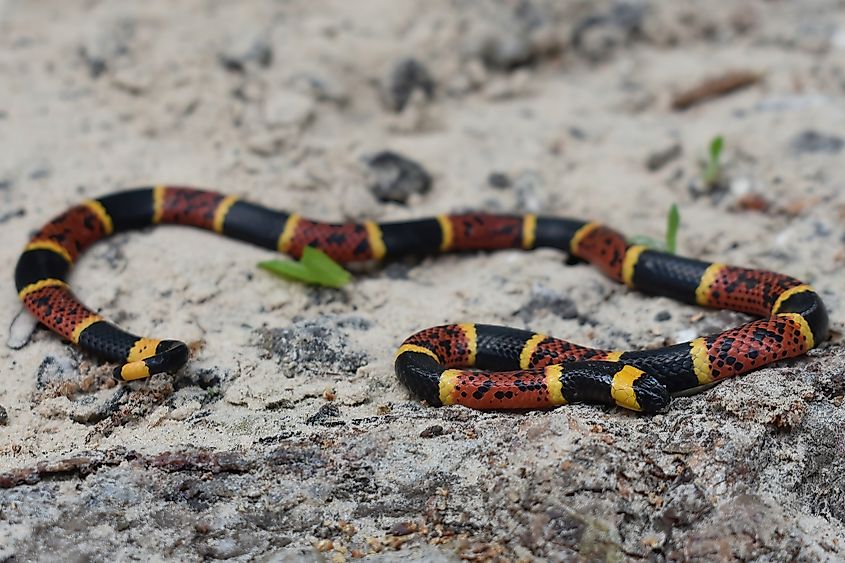
The Texas coral snake is a sub-species of the coral snake and one of Louisiana’s most venomous snakes. As the name suggests, this snake lives in regions of Texas, Louisiana and Arkansas. It boasts a similar coloration to the eastern coral snake, with red and black rings divided by bright yellow rings. The snake itself is quite small, with an average length of 24 inches, although females tend to be slightly longer. Its venom is neurotoxic and myotoxic, which can cause lethal symptoms such as paralysis and the breakdown of tissue. Moreover, Texas coral snakes can deliver over 10 mg of venom in a single bite, but with modern treatment, fatalities are extremely rare.
Venomous Snakes In Both Georgia and Louisiana
While both snakes have their own species of venomous coral snakes, the majority of snakes are common. These are some of America’s most well-known snakes, from the pygmy rattlesnake to the northern cottonmouth, each host to a potent venom that is harmful to humans. While most snakes tend to avoid human confrontation, knowing what to look out for when in these states is important.
Timber Rattlesnake (Crotalus horridus)
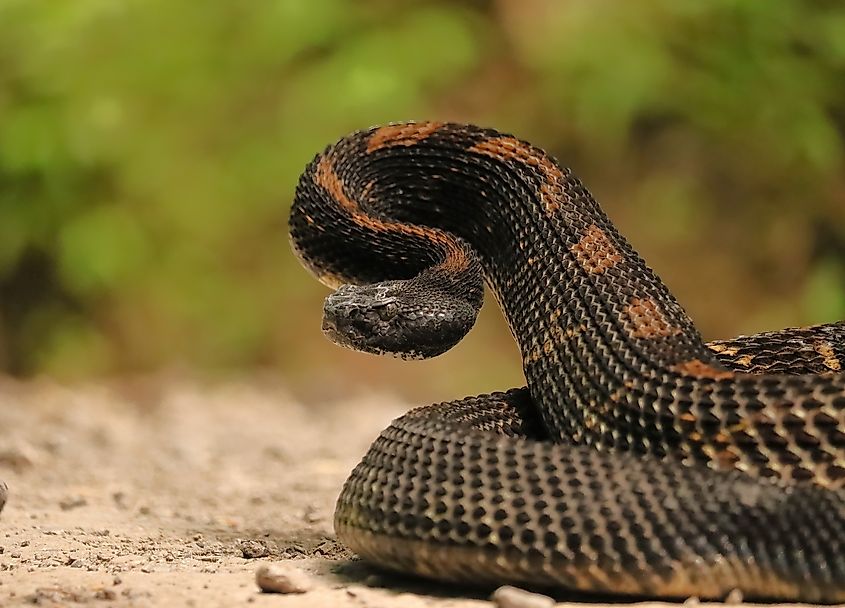
The most common rattlesnake species in the Eastern United States is the timber rattlesnake, which is a venomous species found throughout most of Georgia and Louisiana. Adults can reach lengths between 36 and 60 inches and boast a series of dark crossbands on a brown-gray background. These crossbands have zig-zag edges, which makes it easy to identify these snakes. If spotted in the wild, it is best to give the timber rattlesnake a wide berth as it features long fangs and a high venom yield. Moreover, its venom is neurotoxic and hemorrhagic, resulting in damage to tissue and blood loss, which can be fatal. Thankfully, the snake tends to feed on smaller mammals and animals such as birds and frogs.
Northern Cottonmouth (Agkistrodon piscivorus)
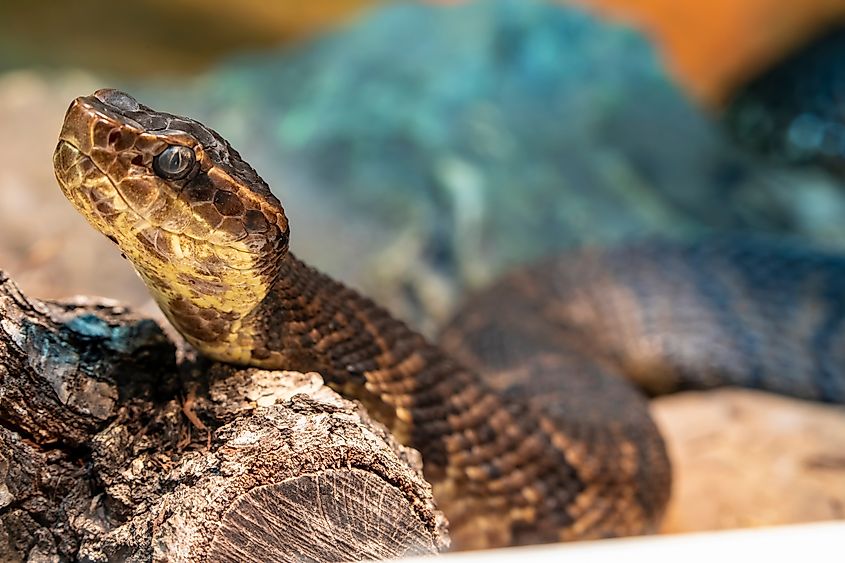
The northern cottonmouth is a venomous snake species native to the Southeastern United States. It gets the name “cottonmouth” from its marshmallow-white inner mouth, which opens when feeling threatened. Apart from its mouth, the snake has a broad head with a dark coloration and dark brown to black crossbands across its body. The average northern cottonmouth can reach a length of 35 inches and weigh up to 20 oz. Its venom is also unique as it is cytotoxic, which can lead to decay in tissue, permanent scarring, and sometimes even amputation. In some cases, further complications can also be fatal, so avoiding these snakes at all costs is always advisable.
Eastern Copperhead (Agkistrodon contortix)
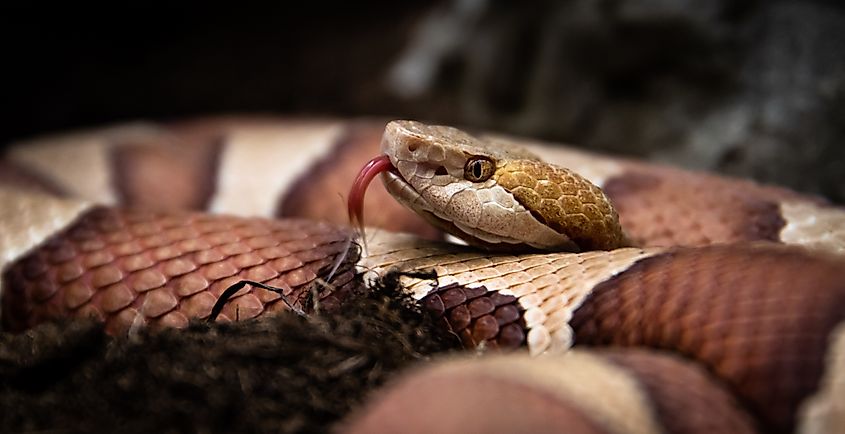
Another member of the Agkistrodon genus, the eastern copperhead, is a pit viper endemic to the Eastern United States. To this end, it is one of the most common venomous snakes in both Georgia and Louisiana. This species has a lighter coloration, with reddish-brown scales and darker hourglass markings across its body. It is also one of the larger snakes on this list, with known specimens reaching up to 3 feet 3 inches long. While its venom is not as potent as other species on this list, it is hemolytic, which can break down red blood cells, leading to pain, swelling, and nausea. Moreover, eastern copperheads tend to freeze when threatened, unlike other snakes that slither away. So, keep an eye on the ground when outdoors in these states.
Venomous Snake Species in Georgia and Louisiana
When comparing Georgia and Louisiana for venomous snake species, both states host over 40 different snake species, with six venomous species each. Georgia has one unique venomous snake—the eastern coral snake—while Louisiana has the Texas coral snake. Most of the venomous species, such as the timber rattlesnake, northern cottonmouth, and eastern copperhead, are found in both states. As a result, both states are relatively equal in terms of their venomous snake diversity, making it difficult to determine a clear winner. Ultimately, each state has its own unique species to be aware of, but overall, it’s a draw.











